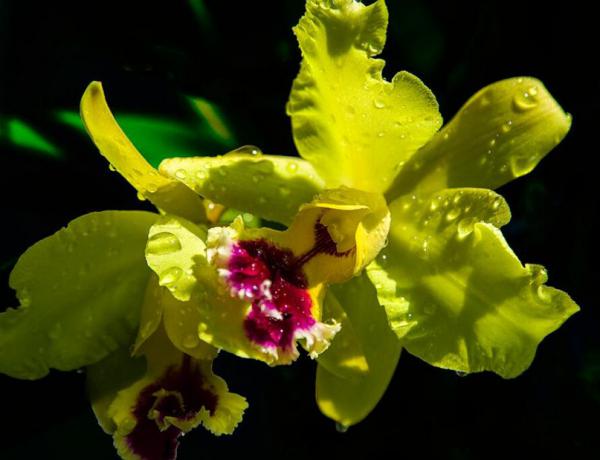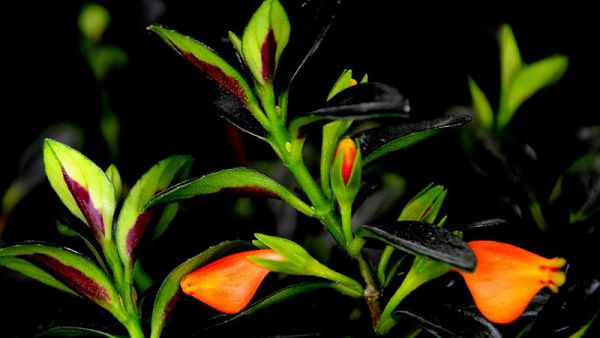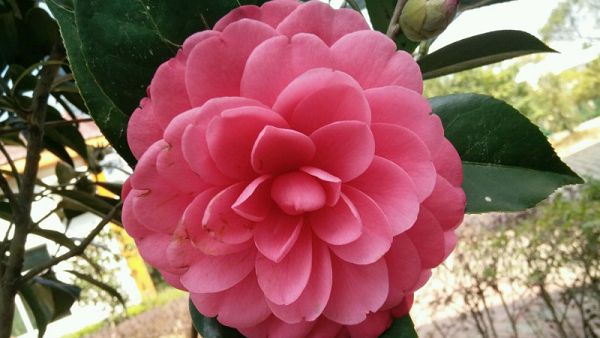The key points of Cartland's knowledge of cultivation Management

This paper introduces the cultivation points of Cartland, including the technical points of preparation, basin change, watering, fertilization and setting up pillars before planting.
1. Preparation before planting
In order to cultivate Cartland well, we must first have a suitable site and excellent environmental conditions, not near the industrial and mining areas with air pollution and the forest of high-rise buildings with poor ventilation and strong radiation. Since Cartland is an epiphytic orchid and is not suitable for maintenance on mud and cement floor, a bench or hanging hanger to prevent pot dumping and an indoor environment with a temperature of no less than 12 ℃ in winter are needed.
For the preparation of pot substrate, Cartland pseudobulbs and leaves are thick, aerial roots are exuberant, and cultivation substrates with good drainage and loose courage are usually used. use more water moss, fern root (the root of the common fern purple dustpan), bark particles (commonly used American red shirt bark, Taiwan longan bark, inland oak bark), broken bricks, zeolite, coconut shell and so on. These potted substrates must be soaked in water before use.
Prepare to plant containers, because there are two ways to cultivate Cartland: potted plants and hanging pots. Pot containers must be permeable courage, commonly used porous mud pots, plastic pots, glazed pottery pots, wood frames, metal frames, etc., hanging pots also need strong plastic and wire hooks.
2. Change the basin
It is generally combined with ramet propagation. Take the orchid plant from the pot, remove the cultivation substrate adhering to the aerial root, separate the false bulb, expose the root system, trim the root and rot root, if the orchid plant grows too vigorously, the bottom part of the root can be removed, each clump has at least 3 pseudobulbs, and with new buds, if the cutting is too small, it will have an effect on the restoration of growth and flowering of the new plant.
When planting, the bottom of the basin is first filled with charcoal or broken bricks with larger particles, which is conducive to drainage, then put a thin layer of cultivation substrate, evenly disperse the roots of Cartland, and then fill the cultivation substrate around it, compacting and planting. Planting should not be too deep, otherwise it will affect the flowering of orchid plants. Note that the new buds must face the rim of the basin and leave a place where they will grow for 2-3 years.
The newly planted Cartland was placed in a semi-shady and humid place within 2-3 weeks, spraying a small amount of water on the leaves every day to keep the leaves and pseudo-bulbs from drying and shrinking. The roots are not watered or fertilized, and the new roots can be watered when they grow 2 to 3 centimeters.
3. Watering
Spring and autumn is the growing season of Cartland, which requires sufficient moisture and high air humidity. But watering needs to wait for the basin matrix to dry, in the morning and evening of the clear day, the action should be slow, so that the pelvic floor matrix can absorb water. If there is always too much humidity or stagnant water in the basin, it will cause root diseases.
Usually do not water, should be in the morning to the orchid plant spray a little water, the same should not be too much. During the vigorous growth period of Cartland in summer, it can be watered once every 2-3 days, and sprinkled water and foliar spray to the ground to increase the air temperature, and the watering time is better in the evening.
In winter, Cartland almost stops growing and is in a dormant state, but he should often spray the leaves of the orchid plant. If the basin is too dry, choose a little water in the morning on a sunny day to make the cultivation substrate moist up and down, and pay attention to that the water temperature should not be too low, otherwise it will hurt the orchid plant and cause water stains and rot patches. When watering in winter, do not leave stagnant water in the leaf core sheath or on the leaf surface, otherwise it is easy to cause rotten heart or rotten leaves. After watering, you can use paper to dry the stagnant water in the leaf surface and leaf core sheath.
4. Fertilization
Although Cartland's aerial roots can absorb nitrogen from the air and synthesize available nitrogen from orchid plants, reasonable fertilization can make seedlings grow faster, orchid plants more robust and flower colors more delicate and beautiful. However, improper fertilization, especially excessive fertilization, is harmful and useless, the light ones are injured and rotten roots, and the serious ones wither and die. Therefore, in the process of cultivating Cartland, it is very necessary to master the scientific method of fertilization.
5. Set up a pillar
Cartland is often placed on the bench or suspended for cultivation in large-scale production. Platform cultivation, there should be a slightly larger bottom groove than the orchid basin base on the planting platform, so that the fixed basin orchid is not easy to dump. When the orchid leaf grows tall and the flower stem is drawn out, the special pillar of the orchid needs to be inserted, and the orchid plant that is too open should be arranged into an upright type with straps, but be careful not to break the flower stem.
The length of the pillar is generally as high as the false bulb, which can not only prevent the orchid plant from lodging, but also have a beautiful shape. For the hanging cultivation of Cartland, in addition to hanging the pot firmly in mid-air, the pot should not be hung too close, so as to prevent the plant leaves from colliding and injuring the orchid plant when the wind blows. When the false bulb is erect and tied to the strut with a strap at the base of the leaf, the end of the strut is bent close to the sheath so that the flower stem can be tied later.
Related
- Fuxing push coffee new agricultural production and marketing class: lack of small-scale processing plants
- Jujube rice field leisure farm deep ploughing Yilan for five years to create a space for organic food and play
- Nongyu Farm-A trial of organic papaya for brave women with advanced technology
- Four points for attention in the prevention and control of diseases and insect pests of edible fungi
- How to add nutrient solution to Edible Fungi
- Is there any good way to control edible fungus mites?
- Open Inoculation Technology of Edible Fungi
- Is there any clever way to use fertilizer for edible fungus in winter?
- What agents are used to kill the pathogens of edible fungi in the mushroom shed?
- Rapid drying of Edible Fungi



